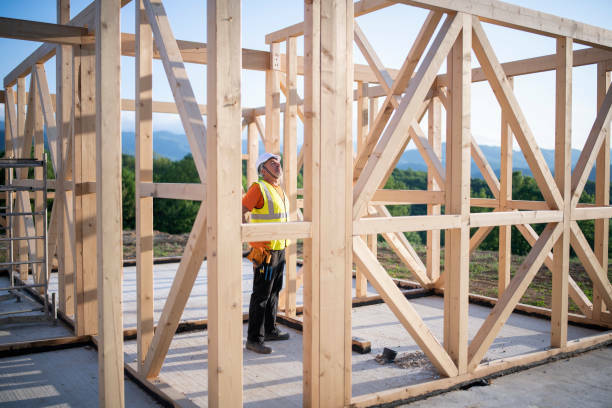
With the current market challenges, it may be tough for borrowers to find the right home. Rather than waiting until the right moment or settling, you may be considering the option to build your own home. That’s where stick-built homes offer an accessible solution.
We’ll go over everything you need to know about stick-built homes, the differences between stick-built homes and system-built homes, and how you may potentially finance building your dream home with a construction loan.
What are stick-built homes?
Stick-built homes are exactly what they sound like—homes that are built stick by stick. Also known as wooden homes or wooden frame homes, they’re built in the traditional way that most buyers probably envision when they think about building a home.
This type of construction allows for endless customization as you may have the opportunity to design your home from the ground up.
Typically stick-built homes require borrowers to work with a builder to create the blueprint of the home and provide the equipment, resources, and labor to complete the build.
Stick-built homes also have to adhere to local building codes and safety standards. With most financing, you’ll have to have an appraisal and inspection to ensure your home is up to code.
Stick-built homes are one option for borrowers, but they’re not the only option. Borrowers may also build a system-built home. Choosing which type of home depends on your financial and home ownership goals.
Stick-built homes vs system-built homes
Stick-built homes and system-built homes offer unique advantages, and understanding the pros and cons of both types of homes may help you in determining your construction.
Stick-built homes potentially offer
- Complete customization
- Durability and longevity
- Resale value
- Wide range of architectural design
- Location flexibility
- Upgradability
- Energy-efficient enhancements
System-built homes potentially offer
- Efficiency
- More predictable timeline
- Quality control
- Energy-efficiency enhancements
- Cost predictability
- Streamlined process
Potential disadvantages of stick-built homes
- Potentially lengthier timelines
- Susceptible to weather
- Potential for errors
- Higher costs
- Possible on-site challenges
Potential disadvantages of system-built homes
- Limited range of customization
- Transportation fees
- Location issues
- Less resale value than stick-built homes
- Construction and transportation coordination
If you’re still unsure which type of build would suit your homeownership dreams, contact a reliable builder, or multiple, to get a quote for each type of home build. You can then review your project plans and get a clear understanding of what fits your needs.
How to finance your stick-built home with a construction loan
Financing your stick-built home is a reasonably straightforward process, and some lenders even offer construction loans that cover all costs throughout the process, including the construction and primary home loan.
A construction-to-permanent loan is a loan that pays for the construction and then converts it into the primary home mortgage once construction is complete.
These construction loans are a major convenience to borrowers as you only have to apply and close once.
With a construction-permanent loan, you may typically expect the following process:
- Research contractors, builders, and lenders in your area
- Create your blueprint with a detailed budget
- Meet with a lender to obtain pre-approval
- Establish a contract with your builder
- Apply for a construction loan
- The underwriter reviews your scenario for approval or denial
- If approved, you’ll close on your construction loan
- After closing, construction begins
- Payments for construction costs will disburse throughout the construction timeline
- Once construction is complete, your monthly mortgage payments begin
Work with a lender experienced in construction loans
You want a lender who understands the complexities of the construction process, helps you understand what a realistic budget could be, and manages construction costs effectively.
It’s important to note that not all lenders offer construction loans, nor do they all offer construction-to-permanent loans.
There are many construction loans, and the right lender will understand your financial needs and homeownership goals to help you select the right construction loan for your situation.
Talk to multiple lenders and ask as many questions as you need to get a feel if they’re the right lender for you.
Types of construction loans
When researching construction loans, it helps to understand your current financial situation. Do you need down payment assistance? Do you have substantial savings? How is your credit score? What are the costs of construction?
These various factors may help you narrow down your search for finding the right construction loan.
Even if your credit score or savings need some time to improve, you still have options.
- Federally backed loans, like FHA, USDA, and VA construction loans, may help borrowers with lower credit scores than what is typically required or who need help making the down payment on their loan. For qualified applicants, there are flexible requirements to make homeownership possible with lower down payment and credit score requirements. However, they also have tighter restrictions, such as loan limits and property restrictions.
- Conforming construction loans, like those provided by Fannie Mae or Freddie Mac, are another option for borrowers. These loans adhere to conforming loan limits that the Federal Housing and Financing Administration sets. Conforming construction loans are construction-permanent loans available to borrowers who meet specific criteria.
- A jumbo construction loan may work if you have considerable savings, big plans for your home, and live in a high-cost area. They allow borrowers to fund more expensive projects. However, because of the higher loan amounts, they come with tighter requirements, such as higher down payments.
Discuss the different types of construction loans with a qualified lender for the most up-to-date information on loan requirements and guidelines. They may review your project plans and help you determine which loan would help you match your financial scenario.
Get financing for your stick-built home
If you’re ready to apply for a construction loan for a stick-built home, then don’t wait any longer.
Work with The Federal Savings Bank to receive step-by-step guidance and a streamlined process when you apply online.
No matter what type of home you’re seeking to build, we have options and experience to help you through the process. Home begins here.
Subject to credit approval. Terms and conditions may apply. Subject to VA eligibility requirements. Property insurance is required on all loans secured by property.
Down payment assistance requirements are based on the mortgage insurer or guarantor’s guidelines. Borrower may fund down payment and closing costs. Down Payment Assistance Program, which assist eligible homebuyers with purchasing a home. Down payment assistance programs are not eligible for all potential homebuyers.
This article is intended for general informational and educational purposes only and should not be construed as financial or tax advice. For more information on financial planning or investment advice, consult a registered investment advisor or financial planner. For tax advice, please consult a tax professional.
This information is intended for educational purposes only. Products and interest rates subject to change without notice. Loan products are subject to credit approval and include terms and conditions, fees and other costs. Terms and conditions may apply. Property insurance is required on all loans secured by property. VA loan products are subject to VA eligibility requirements. Adjustable Rate Mortgage (ARM) interest rates and monthly payment are subject to adjustment. Upon submission of a full application, a mortgage banker will review and provide you with the terms, conditions, disclosures, and additional details on the interest rates that apply to your individual situation.


